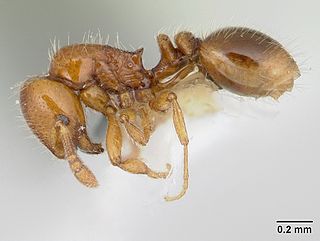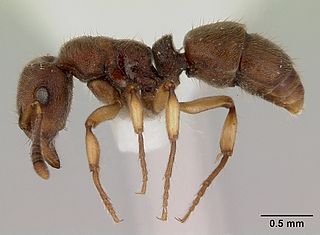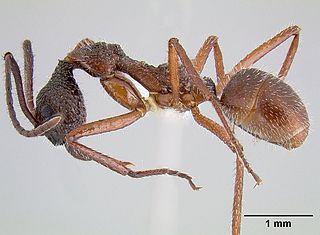
Odontomachus is a genus of ants commonly called trap-jaw ants found in the tropics and subtropics throughout the world.

Oxyepoecus is a Neotropical genus of ant in the subfamily Myrmicinae. The genus is a member of the tribe Solenopsidini and currently includes 20 species.

Acanthognathus is a genus of ants that are found in tropical Central and South America. There are 7 living species and 1 extinct species, Acanthognathus poinari, known only from fossil records.

Anochetus is a genus of small, carnivorous ants found in the tropics and subtropics throughout the world.

Procryptocerus is a Neotropical genus of gliding ants, with the ability to "parachute" by steering their fall if they drop off of the tree they're on.

Dolichoderus is a genus of ants found worldwide.

Rhopalothrix is a genus of ants in the subfamily Myrmicinae.

Agroecomyrmecinae is a subfamily of ants containing two extant and two fossil genera. The subfamily was originally classified in 1930 by Carpenter as Agroecomyrmecini, a Myrmicinae tribe. Bolton raised the tribe to subfamily status in 2003, suggesting that Agroecomyrmecinae might be the sister taxon to Myrmicinae. It has since been discovered to be one of the earliest lineages of ants, a clade from the basal polytomy for all ants. In 2014, the subfamily was expanded to two tribes. The tribe Ankylomyrmini was moved from the subfamily Myrmicinae to Agroemyrmecinae.

Tatuidris, or armadillo ant, is a rare genus of ants consisting of a single species, Tatuidris tatusia. The ants are small in size and inhabit the leaf litter of Neotropical forests in Central and South America, from Mexico to Brazil. Workers are ferruginous-colored to dark red and present a distinctive morphology, consisting of a shield-like head with a broad vertex, ventrally-turned heavy mandibles which do not overlap at full closure, and unique among ants – an antenna socket apparatus sitting upside-down. Little is known about the biology of the ants, but they are likely nocturnal and specialist predators.

Heteroponera is a genus of ants in the subfamily Heteroponerinae. The genus is known from the Neotropics and Australasia.

Megalomyrmex silvestrii is a Neotropical species of ants in the subfamily Myrmicinae. Megalomyrmex silvestrii is widespread in the mainland Neotropics from Mexico to northern Argentina. This species occurs in moist to wet forest habitats, from sea level to 1100 m elevation. It nests in small chambers in rotten wood or opportunistically in other small cavities in the soil. Colonies have been found in small attine nests and alone, suggesting it is a facultative predator of small Attini.
Acanthognathus poinari is an extinct species of ant in the subfamily Myrmicinae known from a single possibly Miocene fossil found on Hispaniola. A. poinari is the first species of the ant genus Acanthognathus to have been described from fossils found in Dominican amber and is one of several species of Acanthognathus found in the Greater Antillas.

Acanthognathus brevicornis is a species of ant belonging to the genus Acanthognathus. Described in 1944 by Smith, M.R., the species is native to northwestern South America.
Acanthognathus laevigatus is a species of ant belonging to the genus Acanthognathus. Described in 2009 by Galvis & Fernández, the species is native to Colombia.

Acanthognathus lentus is a species of ant belonging to the genus Acanthognathus. Described in 1922 by Mann, the species is native to Central America and South America.

Acanthognathus rudis is a species of ant belonging to the genus Acanthognathus. Described in 1969 by Brown & Kempf, the species is native to South America.
Acanthognathus stipulosus is a species of ant of the genus Acanthognathus. Described in 1969 by Brown & Kempf, the species is native to South America.

Pseudoponera is a small genus of ponerine ants. The genus was described by Emery in 1900.
Heteroponera monticola is a species of ant in the genus Heteroponera. Described by Kempf and Brown in 1970, Colonies are mainly inhabit high wet regions in Colombia, particularly in parts where ants of whatever kind are scarce.

Dolichoderus attelaboides is a species of ant in the genus Dolichoderus. Described by Johan Christian Fabricius in 1775, the species is endemic to Bolivia, Brazil, Ecuador, French Guiana, Guyana, Peru, Suriname and Trinidad and Tobago.

















